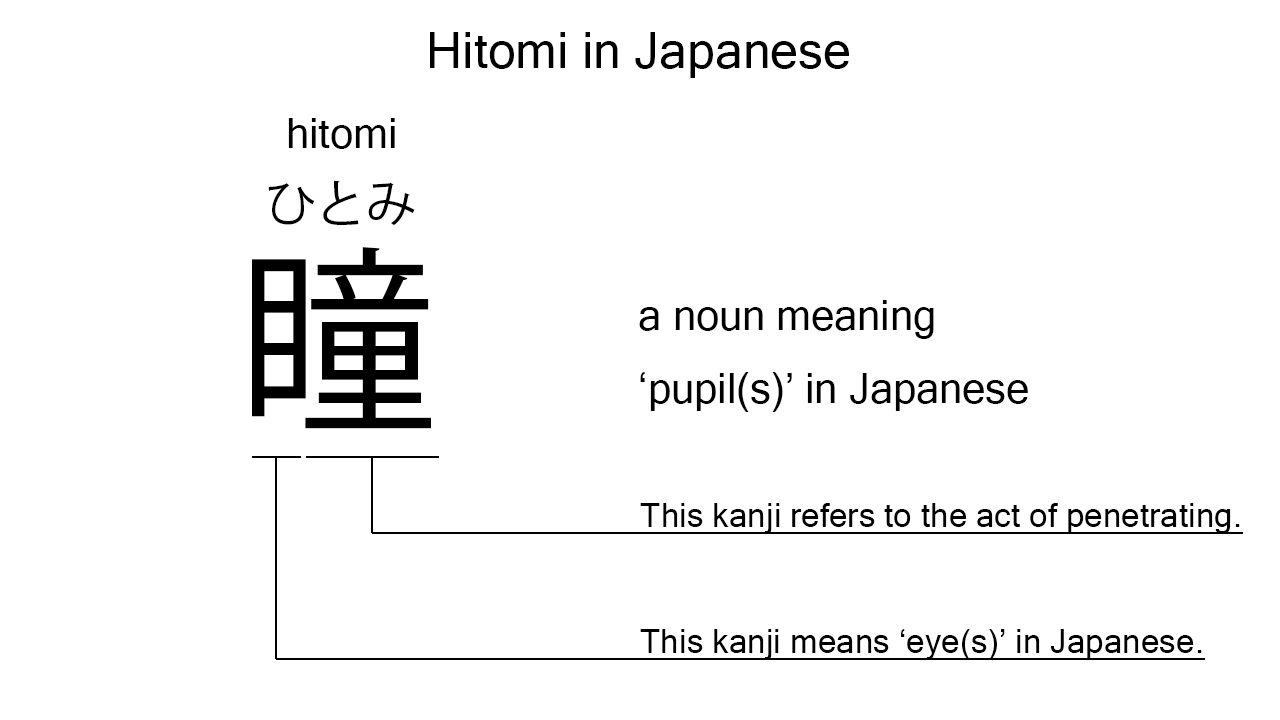What does “hitomi” mean in Japanese?
Native speakers say “hitomi” to mean ‘pupil’ in Japanese. Perhaps, some Japanese learners know this word as it is sometimes used in Japanese movies, songs, novels, manga, anime, and the like. In this blog post, however, I will explain this word in detail based on its kanji character. And also, I will explain how to use it through example sentences. My explanations would help Japanese learners understand “hitomi” more clearly. Then, let’s get started!
Contents
Definition and meaning of “hitomi”
Let me start with the definition and meaning of “hitomi”.
- hitomi – 瞳 (ひとみ) : a noun meaning ‘pupil’ in Japanese. This can also work as plural. Learn more about Japanese plural.
Japanese native speakers use this noun to refer to the center part of an eye.
The definition and meaning are simple and clear. To understand this noun more clearly, however, let me explain its kanji character in detail.
Hitomi in kanji
The kanji character of “hitomi” consists of the following two parts:
- 目 : a kanji character widely used to mean ‘eye’ in Japanese.
- 童 : a kanji character used to refer to the act of penetrating.
These two parts tell us that the formed character literally means a ‘penetrated eye’ in Japanese. This literal interpretation is not in line with the actual meaning, but still understandable, I think. A pupil indeed looks like a hole at the center of an eye ball.

When we meet new kanji characters, we should check their parts in detail to understand their meanings clearly and deeply. In many cases, kanji parts tell us a lot about the meanings of the characters they form. Actually, here, we could get the better understanding of “hitomi” through the detailed check above.
So far, I’ve explained the definition and meaning of “hitomi” together with its kanji parts. Then, let me explain how to use it through the example sentences below.
Example #1: how to say “pupils” in Japanese
watashi no hitomi wa totemo chiisai – 私の瞳はとても小さい (わたしのひとみはとてもちいさい)
My pupils are very small.
Below are the new words used in the example sentence.
- watashi – 私 (わたし) : a pronoun meaning ‘I’ in Japanese.
- no – の : a case particle used after a noun or pronoun to make its possessive case. In the example, this is used after “watashi” to make its possessive case, “watashi no“, which means ‘my’ in Japanese.
- wa – は : a binding particle working as a case marker or topic marker. In the example, this works after “watashi no hitomi” to make the subject in the sentence.
- totemo – とても : an adverb of degree meaning ‘very’, ‘much’, or such in Japanese. In the example, this works in front of “chiisai” to emphasize its meaning.
- chiisai – 小さい (ちいさい) : an i-adjective meaning ‘small’ in Japanese.
This is a typical usage of “hitomi”. In this example, it works together with the possessive case, “watashi no”, to say “my pupils” in Japanese.
Example #2: another usage of “hitomi”
boku wa kanojo no hitomi ga suki desu – 僕は彼女の瞳が好きです (ぼくはかのじょのひとみがすきです)
I love her pupils.
Below are the new words used in the example sentence.
- boku – 僕 (ぼく) : a pronoun meaning ‘I’ in Japanese. This is used mainly by boys and young males.
- kanojo – 彼女 (かのじょ) : a pronoun meaning ‘she’ in Japanese. In the example, this works together with the case particle, “no”, to mean ‘her’ in Japanese.
- ga – が : a case particle used to make the subject word or the object word in a sentence. In the example, this is used after “kanojo no hitomi” to make the object in the sentence.
- suki – 好き (すき) : the stem part of the na-adjective, “sukina”, which means ‘favorite’ in Japanese. Native speakers, however, often use this as an individual word to mean ‘to like’ or ‘to love’ in Japanese. In the example, this is used to mean ‘to love’.
- desu – です : an auxiliary verb used after a noun or adjective to make it polite. Probably, this is well known as a part of Japanese desu form. In the example, this is used after “suki” to make it sound polite.
This is another typical usage of “hitomi”. In this example, it works as a part of the object in the sentence. Anyway, when we want to mean a ‘pupil’ or ‘pupils’ in Japanese, this noun is always a very good option.
Summary
In this blog post, I’ve explained the definition and meaning of “hitomi” in detail based on its kanji character. And also, I’ve explained how to use it through the example sentences. Let me summarize them as follows.
- hitomi – 瞳 (ひとみ) : a noun meaning ‘pupil’ in Japanese. This can also work as plural. The left part of the kanji means an ‘eye’ in Japanese and the right part refers to the act of penetrating. So, this kanji character literally means a ‘penetrated eye’ in Japanese. This literal interpretation is not in line with the actual meaning, but still understandable, I think. A pupil indeed looks like a hole at the center of an eye ball.
Hope my explanations are understandable and helpful for Japanese learners.